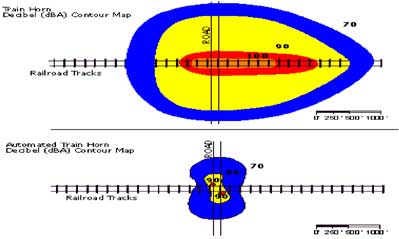Issue 22
 |
QUIET ZONES |
Quiet Zones are defined as a section of a rail line that contains one or more consecutive public crossings at which locomotive horns are not routinely sounded by someone on the train. At first thought quiet zones seem like a good thing: reduce noise around tracks to improve quality of life for residents of a community. But I am reminded of one of the first things I was taught when I entered my career with the railroad: for every rule there is a loss behind it. The rules of a train sounding the horn were implemented for very good reasons. Quiet zones once put into place allow train movement without sounding the horn for grade crossings. They are mostly used in heavily populated areas where excessive noise caused by train horns is considered a nuisance. But noise is a pretty effective way of alerting motorists, cyclists, or pedestrians of an oncoming train. So there exist a rivalry of sorts between safety and comfort. I would prefer we be more concerned with safety over comfort. This is not to say that safety is completely disregarded in the planning of quiet zones. To set up a quiet zone the officials in the area must review the (QZRI) Quiet Zone Risk Index. If it is less then the (NSRT) National Significant Risk Threshold, the quiet zone may be implemented. If the QZRI is not sufficient, a quiet zone may be set up using SSM’s. Basically railroads must block a grade crossing with the approved supplemental safety measures (SSMs) or use a wayside horn system that projects the noise down the street. The SSMs are a four quadrant gate system: Train-activated warning gates that, when lowered, fully block highway traffic from entering the crossing. Gates lower across both approach and departure lanes on both sides of the crossing. A two quadrant system may be used on a one way street. Medians or channelization devices at gated crossings keep motorists from going around crossing gates. They may also either permanently close a grade crossing or temporary close the crossing during nighttime hours. My main problem with the SSMs is you’re taking away an audible warning and replacing it with a physical obstruction. Although a physical obstruction is a nice added feature studies have shown the wayside horn leaves a smaller footprint than a traditional train-mounted horn. Therefore someone distracted by a car stereo or taking their eyes off the road may not have a sufficient warning. A
wayside horn is considered a one-for-one replacement for train horn
activation. A wayside horn is defined as: A
stationary horn located at a highway-rail grade crossing that is
designed to provide audible warning to oncoming motorists when a
train is approaching. The horn is controlled by the same track circuits
that operate the automatic warning devices at the crossing. The
wayside horn is sold under the name Automated horn system and may
also be called a directional horn because it is aimed down the street
with little disturbance to houses near by. Although it is considered
a one-for-one replacement the AHS has a much smaller footprint. With
the graph below you can see that the AHS clearly concentrates noise
down the roadway, but it is not covering as much territory with as
much intensity as the train-mounted horn. If I were concerned just for the nuisance of the train horn the AHS would be acceptable. But the clear fact is the train horn is heard at a greater distance than the wayside horn. Now the old saying come to mind, don’t put all of your eggs into one basket. With all of the vital electronics depending on the track circuit, and track circuits are prone to malfunction for various reasons including track condition, weather, etc., relying on it to operate the gates, lights, bell and the train horn is an overload at best. Doppler Effect is another thing we should consider with permanently mounted wayside horns. It is defined as, a change in the observed frequency of a wave, as of sound or light, occurring when the source and observer are in motion relative to each other, with the frequency increasing when the source and observer approach each other and decreasing when they move apart. The motion of the source causes a real shift in frequency of the wave, while the motion of the observer produces only an apparent shift in frequency. Most people may not know what to call it, but everyone notices the Doppler Effect as noise from an object in motion. I find this very important if a crossing is in trouble. With a wayside horn if the crossing is in trouble the horn sounds and it’s just part of the noise associated with the crossing, but if the horn is mounted on the train everyone will notice that the noise is in motion and danger follows. Because I was a maintainer in the past a few questions come to mind. Are the AHS tested as part of the crossing? Are maintainers given a way to test SPL, and a way to test the tone of the AHS? Are AHS considered an upgrade for all crossings or only new installations? If considered for an older installation are the batteries and chargers upgraded as well? And is there a procedure for a catastrophic failure including loss of battery backup? Repeated calls to RCL, PUCO, and the FRA for clarification on these questions have gone unanswered to this point. http://www.volpe.dot.gov
(Disclaimer: The views, opinions, and subject matter are based upon Mr. Wilson’s personal experiences and are not those of the Foundation. The Foundation in no way expresses expertise or common knowledge of its content). |
©2007 The Angels on Track Foundation. All rights reserved. | Trademark &
Copyright Notice | Site Map
